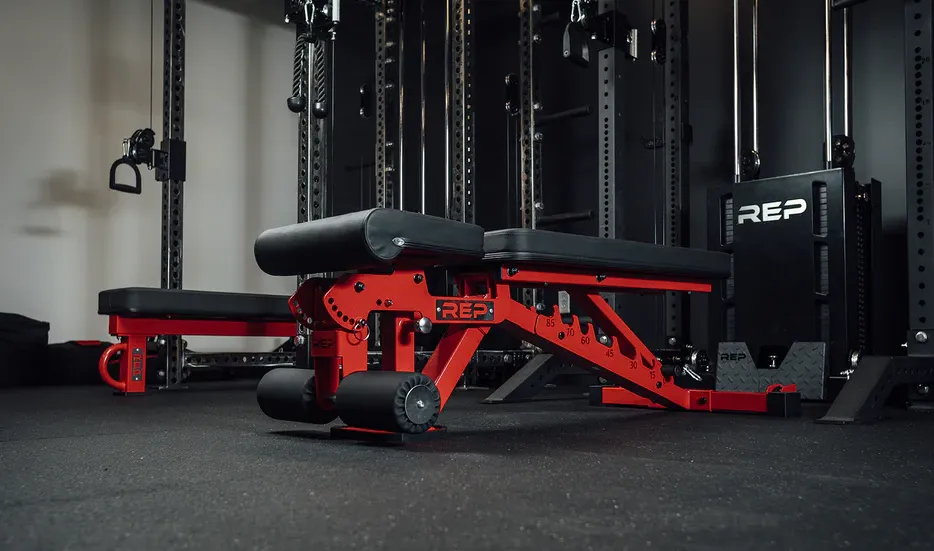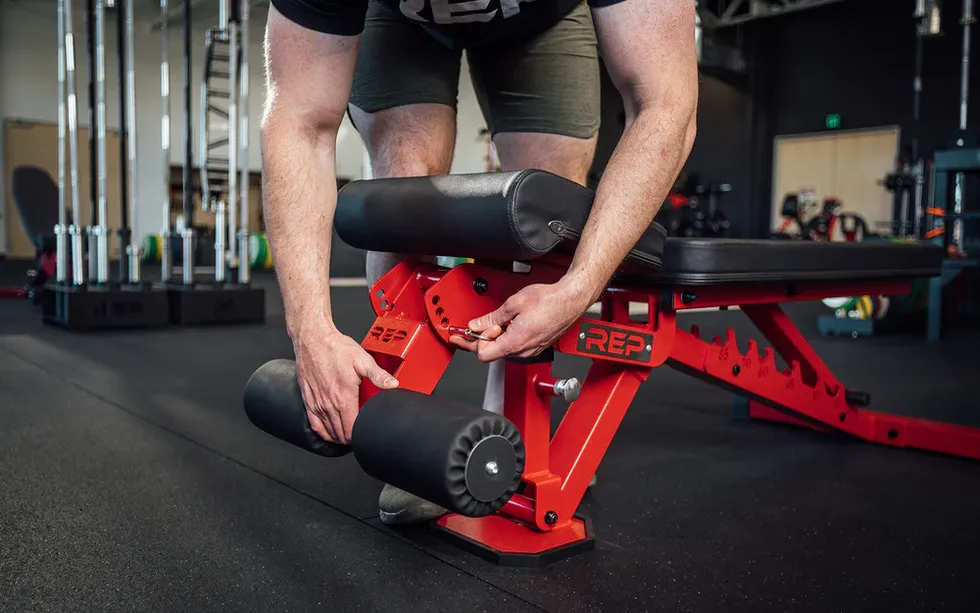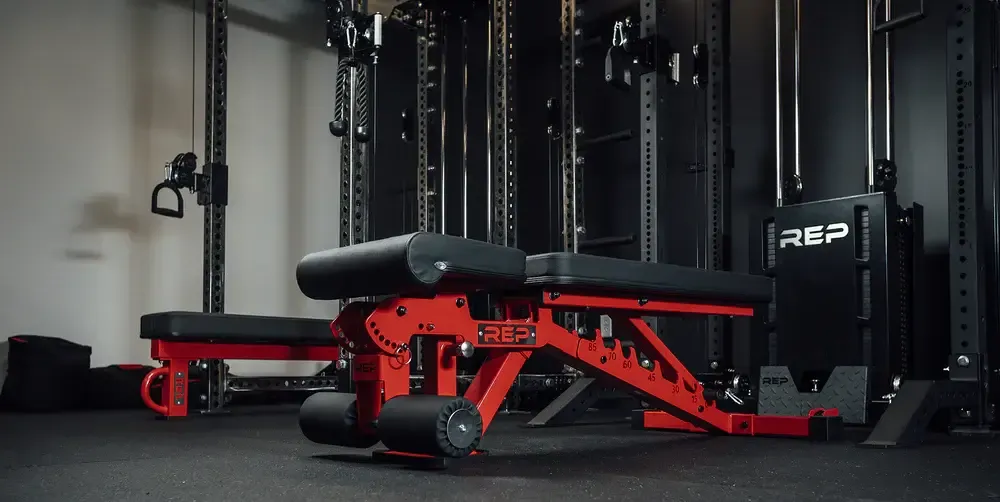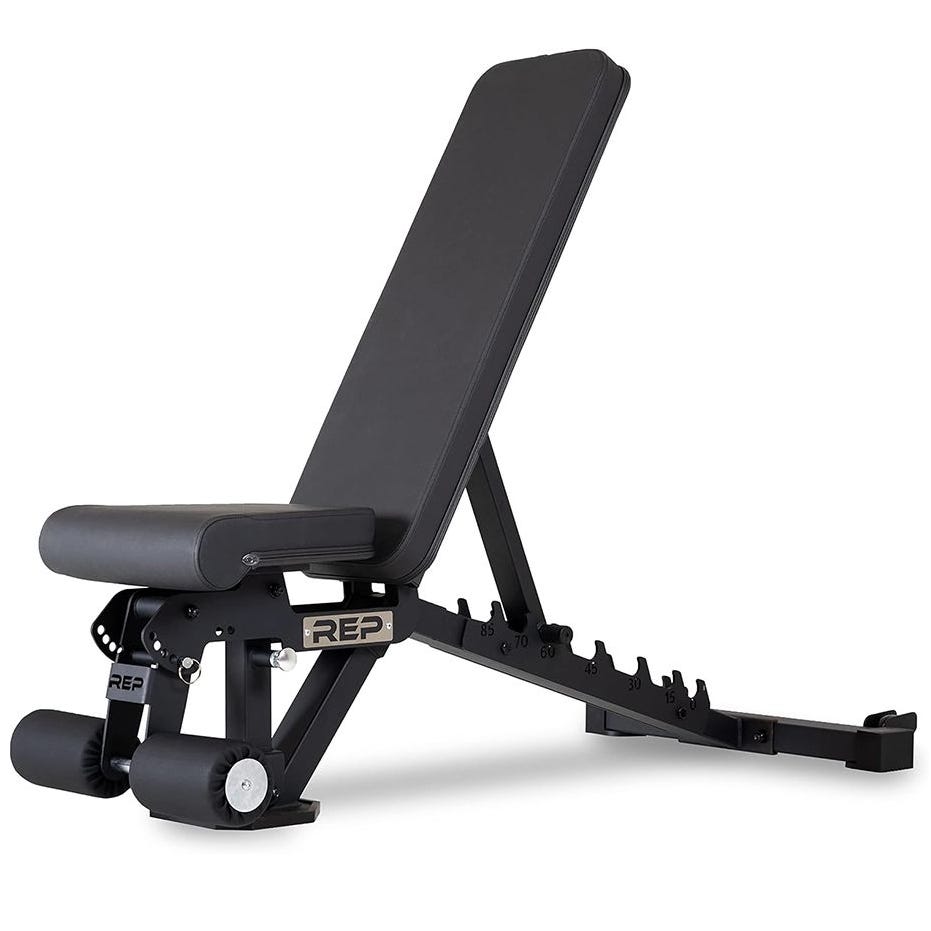A WEIGHT BENCH—specifically an adjustable one—is non-negotiable in my home gym, and it should be in yours too. It provides a stable base for pressing, rowing, and stabilizing during heavy lifts. At the same time, adjustable models offer a whole new range of angles to target different muscles, and thus, more exercises. Opt for a cheap bench, though, and you’ll second-guess every rep, worried about if and when it’ll give out. Sure, you could spend $600+ on a top-tier model, but a mid-range option offers the best value for most lifters. One of the most popular in this category is REP’s AB-3000.
REP Fitness AB-3000 Adjustable Bench
REP Fitness, based in Colorado, is recognized for producing high-quality gym equipment, including power racks, kettlebells, dumbbells, and cable machines. One of their standout products is the AB-3000, a flat-incline-decline (FID) adjustable bench made with premium materials, all priced under $400. “You won’t find a bench that gets the basics right better than this one,” says MH fitness director Ebenezer Samuel, C.S.C.S. “It’s consistent, reliable, and durable — and that’s everything you want at this price point.”
The REP Fitness AB-3000 earned a spot in the Men’s Health best weight benches guide after being tested by the MH editors. But to do an even deeper dive on this piece of equipment, they coordinated with REP to send me a model to review. I put it through several weeks of workouts to test its reputation as a solid mid-range option for lifters seeking performance without the steep price tag.
Shipping and Assembly
The bench is delivered in one large box that weighs nearly 100 pounds. If you live in a walk-up apartment like me, I suggest having someone help you carry this up the stairs. Even if you can handle the weight yourself, the box is cumbersome and difficult to maneuver. Be aware that the back pad doesn’t latch into place, so you must carry it from the bottom, not the back pad bar.
The assembly process wasn’t complicated, but I wouldn’t say it was a breeze either. The bench comes in four parts: the back bar, back pad, seat pad, and handle/leg rollers. REP includes all the necessary hardware, including a couple of Allen wrenches; however, I found that using my crescent wrench sped things up.
One mildly frustrating part of the process was screwing in bolts that required caps on both ends. The Allen wrench helps, but holding one side steady while twisting the bolt into place can be a delicate balancing act. The seat also gave me some trouble. Tightening the bolts on the bottom was awkward, but after a few finger turns, I was able to provide them with a final crank with my wrench.
All in all, leave yourself an hour to unbox and assemble this bench with minimal breaks. You can do it solo, but putting it together near where you’ll use it is a smart move—remember, this thing weighs almost 100 pounds.

Rep Fitness
Standout FeaturesAB-3000 vs. AB-3000 2.0: Key Differences
I’ll dive into the significant differences between the two benches below, but here’s a quick breakdown of what’s the same and what’s new with REP’s AB-3000.
What’s New
- More back pad angles for added versatility
- Protective rubber covers on the front and back feet
- A squared-off back pad for increased surface area
- New, denser, and grippier CleanGrip® padding
- Wider back leg for enhanced stability
- Horizontally positioned bench handle, now built into the leg roller
- Additional color options: Metallic Black, Red, Blue, White, Matte Black
What’s The Same
- Supports up to 1,000 pounds
- Ladder-style adjustment system
- Flat, incline, and decline (FID) capabilities
- Built-in leg roller
- Adjustable seat angles
Adjustment System
My favorite feature of this bench is the ladder-style adjustment system. While most benches rely on a pin mechanism—requiring you to pull a latch, lift the back pad, and wait for the pin to click back into place—the AB-3000 takes a more efficient approach.
The ladder system uses a crossbar that slides easily into preset grooves, making adjustments fast and straightforward—no pins or latches required. Lowering the bench is just as easy: pull the crossbar out and manually place it in the groove of your choice. It’s the fastest and simplest adjustment system I’ve used.
REP also added dampeners to the crossbar, making the process quieter than expected. I used the bench while my nine-month-old son was napping, and the adjustment noise never caused a stir.
Backpad Angles
REP revamped the AB-3000’s back pad angles based on lifter feedback. The 2.0 model offers eight back pad angles (up from seven), with the negative 12-degree and 85-degree remaining the same. The bench also includes five seat angles, ranging from five to 20 degrees, all controlled by a pin adjuster.
In a blog post on REP’s website, the company says that they made these back pad angle changes in part because research found that 30 and 45 degrees were the most optimal pressing angles for chest development. The original AB-3000 had 35- and 50-degree angles, but this updated design better aligns with those findings.
Seat Pad
The seat pad on REP’s flagship bench is reversible, allowing you to position it depending on whether you want the bench to taper in or out at the bottom. REP suggests positioning the wide side at the front to protect the back of your knees during decline work, while the narrow side is more suited for standard pressing.
I keep the narrow side facing forward since I use the bench primarily for flat and incline presses rather than decline work. Also, my pressing stance tends to be wider, and the narrow setting allows me to get into position without my knees hitting the sides of the seat pad.
Switching the seat pad is a bit of a hassle, so it’s not something you’ll want to do often. My advice is to loosely screw in the seat to try both positions during assembly. Once you’ve found your preferred seat position, stick with it. Either position works, so go with what’s more comfortable.

Rep Fitness
Leg Roller
Both versions of the AB-3000 feature a leg roller that locks your feet in place during decline exercises. For the 2.0 model, REP re-engineered the leg roller to move independently of the seat, allowing for a more customized fit. The addition of sliding pins makes adjusting the roller quick and easy.
What Using the AB-3000 Is Like
For all the high-end features the AB-3000 boasts, a good weight bench ultimately needs to do one thing: support you without any mechanical failures. And this bench delivers. It’s built like a tank—solid, stable, and wobble-free. The dense padding feels substantial, and the leg roller stays perfectly still while my feet are locked in, giving me confidence that I’m not going to tip over mid-rep.
A key upgrade in the 2.0 version is the wider rear leg (REP doesn’t specify exactly by how much). This added width prevents side-to-side wobbling, making for a sturdier bench. The two-inch-thick pads create a solid foundation for pressing and rowing, while the back pad—almost 12 inches wide—provides ample upper back support and enough space for my arms to move freely. The seat, 15 inches wide at its widest point, comfortably supports my entire butt, helping me stay locked in during presses.
It’s worth noting that when the bench is flat, there’s a two-inch gap between the seat and back pad. Pad gaps are common in adjustable benches; they need room to shift when adjusting the angles. During flat presses, you might feel your lower back and butt settle into the gap. Personally, it doesn’t affect my form, but the AB-3000’s wide, long pads make it easy to adjust your position to avoid the gap altogether.
The laser-cut angle markings are a thoughtful addition that ensures precise, repeatable adjustments for consistent training. Most benches I’ve used in the past don’t feature any indicators, which means I often have to guess where I last set the angle. It’s a minor annoyance, but for anyone who values consistent progression and form (like me), the clear markings make it easy to track your settings and maintain consistency.
Another standout feature is the AB-3000’s negative 12-degree decline angle. You won’t find this in most commercial gym benches, though many gyms offer standalone decline benches. I mostly use the decline for sit-ups and dumbbell presses, and while other benches might offer a steeper decline, I don’t feel the need to lie back any further.
At first, I found the decline setting awkward. I didn’t angle the seat upward as the back pad angled down. (Pro tip: If you own this bench, make sure the seat and back pad align to form a straight line.) Also, because I keep the narrow side of the seat pad facing forward, half of my hamstrings rest against the seat pad, while the other half doesn’t. It’s not a deal-breaker, but if you use the decline often, I’d recommend switching the seat around with the wide side facing forward for more comfort.
The leg rollers also took a little getting used to. They’re only necessary during the decline, so when I’m doing flat or incline work, I’m careful to position my feet so I don’t bump my ankles. After a short adjustment period, I got the hang of it, but initially, they felt a little off.
If you’re not using the decline, the leg roller can be removed with a wrench in about a minute. Alternatively, I prefer to slide the roller all the way back and insert the pin into the highest slot. This pin acts as a stopper, allowing the pad to move freely when needed, but it falls right back into place when you’re done. Keep in mind, the roller might be stiff at first, so you may need to give it a firm push until it loosens up.
All in all, the AB-3000 is stable, comfortable, and thoughtfully designed by engineers who understand what lifters want from a bench. With a broad range of adjustable angles, easy customization, and small yet impactful details like the laser-cut angle markings, this bench is a great grab for anyone looking to elevate their home gym.
Value
Don’t let the price tag fool you—REP’s AB-3000 offers exceptional value. Of the eight benches REP lists on its website, the AB-3000 is the fourth cheapest option, yet it stands out in terms of quality. It’s tough to find an FID bench of similar caliber at this price point. (Rogue’s entry-level adjustable bench, for example, retails for $595.)
REP has significantly upgraded the AB-3000 with the second iteration, improving stability, enhancing padding, and giving the bench a more polished aesthetic. Whether you’re buying your first bench or upgrading your setup, the AB-3000 offers everything you need in a weight bench (unless, of course, you’re after a specialty model.)
Final Verdict: Should You Buy the AB-3000
I’ve tested a lot of high-end equipment—$1,000 recovery boots, a luxurious Nordic curl bench, portable massage guns—and often find myself saying something like, “Sure, there’s a cheaper option, but this product is beautifully made.”
The REP AB-3000, however, is a solid buy for lifters of all experience levels and budgets. For $350, the bench isn’t cheap, but it is worth the money. You’re not going to ever outlift the 1,000-pound weight limit (and, if you do, please let us know). The thick layer of padding won’t ever wear out. And it’s a flat, incline, and decline bench all in one.
If you are on a shoestring budget, then you can certainly find a more affordable adjustable bench that’ll last you a while. But considering how integral a weight bench is to your home gym set up, I say the AB-3000 is worth it. You’ll buy it once and be good for the long haul.
REP Fitness AB-3000 Adjustable Bench
More Of Our Favorite Essential Home Gym Equipment
Best Adjustable Kettlebells | Best Home Gym Equipment | Best Dumbbells | Best Barbells | Best Adjustable Dumbbells | Best Power Racks | Best Rowing Machines | Best Medicine Balls
Andrew Gutman, NASM-CPT is a journalist with a decade of experience covering fitness and nutrition. His work has been published in Men’s Health, Men’s Journal, Muscle & Fitness, and Gear Patrol. Outside of writing, Andrew trains in Brazilian Jiu-Jitsu, helps coach his gym’s kickboxing team, and enjoys reading and cooking.
Ebenezer Samuel, C.S.C.S., is the fitness director of Men’s Health and a certified trainer with more than 10 years of training experience. He’s logged training time with NFL athletes and track athletes and his current training regimen includes weight training, HIIT conditioning, and yoga. Before joining Men’s Health, he served as a sports columnist and tech columnist for the New York Daily News.
Charles Thorp is the Fitness and Commerce Editor at Men’s Health, where he shares the best product recommendations in gym equipment, recovery tools, supplements, and more. Following an early life in athletics, Charles became a NASM-certified trainer and began writing programs alongside the most respected coaches in the world.
Since entering the world of fitness content, Charles has had the opportunity to learn from and train alongside high performance individuals from the NFL, UFC, NBA, Formula 1, CrossFit, US Olympics, and Navy SEALs. When he’s not writing about training programs or gear, he can be seen at the gym or in the wild, putting them to the test.


